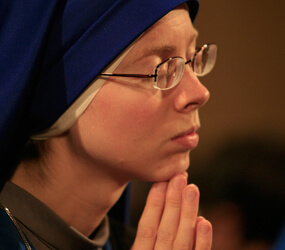WASHINGTON – The Basilica of the National Shrine of the Immaculate Conception – the largest Catholic church in the United States and one of the largest Catholic churches in the world – is celebrating its 50th anniversary but it is still a work in progress, as are the people who worship there, said a West Virginia bishop who was once the shrine’s rector.
“Even as it still looks to the construction of this major dome over us this evening and countless other physical projects to make this an ever more beautiful building, these stones would speak about how this church and every church in Christendom is a ‘work in progress,’ ” said Bishop Michael J. Bransfield of Wheeling-Charleston, W.Va.
“As faithful as we try to be and are, we are not perfect,” he added, which is “why we come to this building to worship” and to be inspired by the Gospel.
Bishop Bransfield, who was the shrine’s rector for 18 years, was the homilist for an anniversary Mass Nov. 19 for the U.S. bishops, who concluded their annual four-day fall general meeting in Baltimore earlier that day.
“We need to hear and ponder the age-old stories of call and response in the Bible, from Abraham and Sarah through Joseph and Mary, Simeon and Anna and all the rest,” Bishop Bransfield said.
“We know well that we are imperfect and that Gospels like these (the Annunciation story proclaimed at the Mass) and the mysteries we celebrate are not optional extras, rather they are our life blood and life support as we seek to be converted more and more fully to the Lord that we worship and whose Gospel we hear through Scripture stories such as these because these stories are announcements to us of what really matters in life.
“If we were perfect,” he added, “we would not need the Gospel, this Eucharist or this building.”
Bishop Bransfield used the rhetorical device “if these stones could speak” to highlight many episodes in the shrine’s history since construction of its upper church was completed in 1959.
“For some this basilica was a place of inspiration and support as they sorted out our new ways to live their Catholic faith” in the years following the Second Vatican Council, he said.
“If these stones could speak they would speak of a house of hope amidst riots in D.C. that occurred in the late 1960s because of racial prejudice and protests against the Vietnam War,” Bishop Bransfield added.
“If these stones could speak they would speak of a house of welcome and of refuge since the early 1970s when Catholics and others have gathered here for the Right to Life Mass on Jan. 21, the feast of St. Agnes,” he said. “That Mass houses literally thousands here and downstairs for the Mass to strengthen them for the march the next day as an important witness for the right of life.”
Bishop Bransfield added, “They would (also) speak of a house of charity and service to the poor to this day on Christmas Day when so many other D.C. agencies are closed but the doors of this basilica are wide open to welcome and feed the poor.”
As a priest Bishop Bransfield began serving at the shrine in 1980 as assistant director and master of ceremonies. From 1982 to 1986 he was director of finance there. Then-Monsignor Bransfield was rector of the shrine from 1986 until he was named a bishop in December 2004.
Archbishop Pietro Sambi, the Vatican nuncio to the United States, read an English translation of Blessed John XXIII’s message on the occasion of the shrine’s dedication in 1959, noting that the shrine had been completed “after so many vicissitudes.” The idea of a shrine was first publicized in 1846, and not given new life until 1910. It was not until 1920 that the foundation stone was laid. Work was interrupted due to the Great Depression and World War II.
The Mass, with Archbishop Donald W. Wuerl of Washington as the principal celebrant, featured more than 50 bishop concelebrants, including Archbishop Edwin F. O’Brien of Baltimore and Cardinal Theodore E. McCarrick, retired archbishop of Washington, who was at the 1959 dedication and was the first chaplain of the Knights of Columbus council based at the shrine.
The Knights have had a long-standing relationship with the shrine. Their contributions include a $1 million donation in 1959 for construction of the shrine’s bell tower and a $1 million gift for the creation and installation of the Incarnation Dome above the south nave of the shrine’s upper church completed in 2008.


